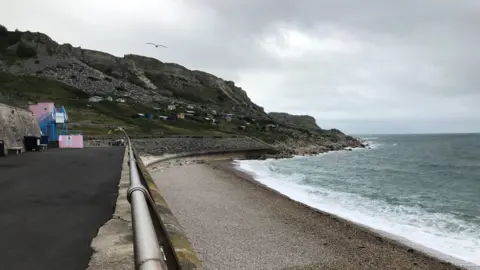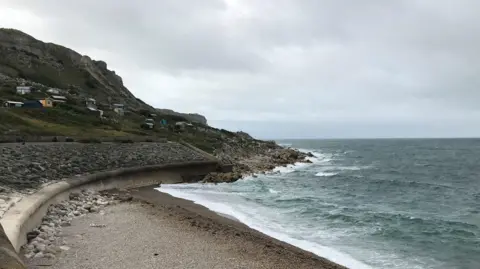Meeting held on work to protect Unesco beach
 LDRS
LDRSThe Environment Agency is likely to dictate the work to protect part of a Unesco World Heritage site, a public meeting has heard.
The online consultation on Monday looked at planned work at Chesil Cove in Dorset, which will include using boulders to protect the curved sea wall.
Some residents want to see the use of local Portland stone in the project, as it is in-keeping with the rocks in the area.
The Environment Agency proposed using longer lasting granite boulders to break up the power of the waves.
The agency has 100-year design standards, which is why they have opted for a revetment made from two layers of 10-15 tonne granite rocks extending 25m seaward from its base.
Some people on the meeting expressed concern that it could result in an "over-engineered" scheme which takes away more beach than a design which might only meet a 30 or 40-year standard.
Rock revetments, like the one proposed, work by slowing down waves and deflecting them away from the sea wall to protect it from erosion.
Details of the plans will be on display, with experts on hand to answer questions, on Wednesday from 13:30 BST at the Portland Community Venue.
Both Dorset Council and consultants, Jacobs, which is advising on the project, stressed that nothing has been decided about the ultimate design with the council first needing to put funding in place.
 LDRS
LDRSEsmari Steenkamp, the council’s coastal risk manager, and Ross Fitzgerald, from Jacobs, which has researched the problem and possible solutions, both said that doing nothing was not an option.
They agreed the gradual decline could potentially lead to further landslips and a risk to the main road and some houses.
Mr Fitzgerald said much of the land movement behind the seawall was being caused by a loss of weight, caused by erosion, at the toe of the structure with corrosion also resulting in a loss of material from behind the wall.
He added that there was mounting evidence of cracks and gullies opening up behind the wall, which indicated ground movement, and with the top of the cliff made up partially of quarry waste the whole area could eventually slip forward towards the sea.
You can follow BBC Dorset on Facebook, X (Twitter), or Instagram.
